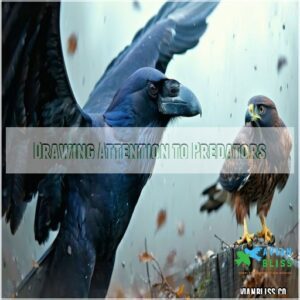This site is supported by our readers. We may earn a commission, at no cost to you, if you purchase through links.
 You’ve probably witnessed the aerial drama: a group of crows daringly dive-bombing a hawk like tiny fighter pilots.
You’ve probably witnessed the aerial drama: a group of crows daringly dive-bombing a hawk like tiny fighter pilots.
These bold birds aren’t just showing off – they’re executing a sophisticated defense strategy called "mobbing."
When crows attack hawks, they’re protecting their nests and young ones through coordinated teamwork.
Think of it as nature’s neighborhood watch program, complete with loud alarm calls that alert the entire crow community to potential threats.
It’s not just about defense, though – these clever corvids sometimes harass hawks purely for sport or to snatch away the predator’s latest catch.
Their tactical genius doesn’t stop there.
Table Of Contents
Key Takeaways
- Crows aggressively defend their nests and young by mobbing hawks, their main predators, using coordinated teamwork and sophisticated tactics like deception, distraction, and intimidation.
- Crows create a neighborhood watch-like warning system, using their distinctive alarm calls to alert the entire crow community to the presence of hawks and other threats.
- Crows don’t just mob hawks out of fear – they also enjoy the thrill of the chase and will sometimes harass hawks just to steal their latest catch.
- While hawks have a size advantage, crows make up for it with their intelligence and ability to work together in groups, making them a formidable foe even for the mighty hawk.
Why Do Crows Attack Hawks?

Ever wonder why crows go out of their way to pick fights with hawks?
It’s not just random bird drama – there’s a fascinating survival strategy at play.
You’ll often spot crows dive-bombing these larger predators, and it’s not because they’re feeling particularly brave or reckless.
Effective crow defense strategy requires coordinated efforts, which is why some people even use specialized products to deter crows from getting too comfortable in their area learn more about crow defense strategy.
Think of crows as the neighborhood watch of the skies.
They’re incredibly smart birds that work together to protect their community from threats.
When they spot a hawk, they’ll launch coordinated attacks not just to chase it away, but to send a clear message to other crows in the area: "Danger ahead!"
By harassing hawks through a behavior called "mobbing," crows effectively create a safer environment for their whole community.
It’s their way of saying, "Not in my backyard!
Territorial Defense
Imagine a hawk soaring into crow territory, and suddenly all hell breaks loose. It’s not random aggression – these bold black birds are running a sophisticated home security system. Crows fiercely defend their turf, especially during nesting season when vulnerable chicks need protection from hungry hawks.
For effective protection, people can also use products specifically designed for Crow Territory Defense.
Like neighborhood watch captains, crows coordinate their defense through a fascinating behavior called mobbing. They’ll dive-bomb, harass, and basically make life miserable for any hawk that dares enter their space. Think of it as nature’s version of shooing away an unwanted party crasher.
Most fascinating is how crows size up different threats. They’re particularly aggressive toward hawks because these predators pose a real danger to their nests and young. It’s not personal – it’s just parental instinct in action.
Alerting Other Crows
You’ll be amazed to see how crows act like nature’s neighborhood watch, using their distinctive caws to alert their fellow corvids when a hawk enters their territory.
When you spot a group of crows mobbing a hawk, you’re actually witnessing their sophisticated warning system in action, where they’ll keep calling until every crow in the area knows there’s an unwelcome predator in their midst.
Drawing Attention to Predators
When danger swoops in, crows spring into action like nature’s neighborhood watch.
You’ll see them mobbing predators with loud, persistent cawing – their version of sounding the alarm.
This clever communication strategy isn’t just noise; it’s a sophisticated warning system that brings the whole crow community together.
Through their distinctive alarm calls, they’re effectively creating a crow-sourced alert network that keeps everyone informed about lurking threats.
Preventing Surprise Attacks
Swooping down from their treetop perches, crows have mastered a clever early warning system against hawks.
You’ll often spot them mobbing potential predators while making distinctive alarm calls – nature’s version of a neighborhood watch.
This coordinated defense strategy alerts the local crow community, but it also makes it nearly impossible for hawks to launch their signature surprise attacks.
Opportunistic Behavior
Beyond their defensive squawking, crows showcase fascinating opportunistic behavior you mightn’t expect. These clever birds don’t just attack hawks out of fear – they actually seem to enjoy the thrill of the chase. You’ll spot them gathering in groups, turning hawk harassment into a coordinated team sport.
Like some bird species, such as blue jays exhibiting mobbing behaviors against predators, they’ll take any chance to assert their dominance.
But there’s more to their mobbing than just showing off. These smart birds use these encounters to score an easy meal, often snatching leftovers from a hawk’s interrupted hunt. They’ve learned that their strength lies in numbers, and they’re not afraid to use it. This behavior demonstrates their remarkable intelligence and social skills – it’s like watching a feathered flash mob with a purpose.
Targeted Predators
You’ll find that crows don’t pick fights with just any bird that crosses their path – they’re specifically targeting hawks and owls that pose a real threat to their survival.
While these clever corvids might seem like bullies as they chase larger birds of prey, they’re actually following a strategic playbook that’s been fine-tuned over generations to protect their families and territory.
Hawks
Hawks rank among nature’s most feared aerial hunters.
Yet crows have mastered the art of turning the tables on these skilled predators through remarkable defensive strategies, and there are many products available to aid in crow hawk defense, such as those found at crow defense items.
Deception, distraction, and intimidation are just a few of these tactics:
| Tactic | Description |
|---|---|
| Deception | Crows feign injury to lure hawks away from nests |
| Distraction | Mobbing draws hawks’ focus, allowing fledglings to flee |
| Intimidation | Large crow groups overwhelm solitary hawks with noise |
Their teamwork proves that sometimes brains beat brawn.
Owls
Just as crows aggressively defend their turf against hawks, these tenacious birds have also mastered the art of outsmarting owls.
Owls’ stealthy, silent hunting style may strike fear in the hearts of smaller prey, but crows have developed clever tactics to turn the tables, likely due to their keen awareness of owl behavior, including their fear of owls.
When owls venture out during daylight, they better watch their backs – that’s when the crows swoop in for a feisty showdown.
Timing of Attacks
You’ll spot crows attacking hawks at any time during daylight hours, but they’re especially vigilant during nesting season when their chicks are most vulnerable.
While owls only face the wrath of crows during daytime hours, hawks don’t get a break since these feisty defenders won’t hesitate to chase them away whenever they spot one near their territory.
Daytime for Owls
When daylight creeps in, owls become surprisingly vulnerable targets for crow attacks.
While these nocturnal hunters try to catch some shut-eye, their roosts become exposed, giving crows the perfect opportunity to strike.
As the sun rises, owls often find themselves in less-than-ideal conditions, far removed from the best time to look for owls, which typically occurs during dusk and dawn.
You’ll spot crows using an impressive arsenal of tactics:
- Relentless cawing and dive-bombing
- Strategic feather-pulling
- Aerial "presents" (yes, that means poop)
These daytime raids serve as the crows’ insurance policy against nighttime predation.
Anytime for Hawks
Unlike their owl-focused attacks, crows don’t wait for specific times to confront hawks.
You’ll spot these aerial showdowns throughout daylight hours, with peak activity at dawn and dusk.
Check out this pattern:
| Time | Hawk Mobbing |
|---|---|
| Dawn | High |
| Midday | Moderate |
| Dusk | High |
| Nighttime | Low |
These smart birds stay ready, defending their turf whenever hawks dare to cruise by.
Frequently Asked Questions (FAQs)
Why do crows chase Hawks?
Picture a fearless squadron of crows diving through the sky.
You’ll often see these protective parents chasing hawks away from their nests and territory.
Using group tactics to defend their young from these fierce predators.
Why do crows chase away hawks?
Crows aggressively chase hawks to protect their nests and young ones from these skilled predators.
They’ll team up with other crows in a mobbing strategy to drive the threat away from their territory.
Why do crows attack Hawks?
You’ll often spot these fierce protectors dive-bombing hawks to defend their nests and territory.
They’ll team up in groups, using their mobbing tactics to chase away these bigger predators who might threaten their young ones.
Are Hawks afraid of crows?
While these mighty kings of the sky aren’t typically afraid of anything, they’ll think twice when crows show up.
Hawks often retreat from mobbing crows, not out of fear, but to avoid unnecessary conflicts.
Do hawks kill crows?
Hawks absolutely can and do kill crows when hunting for prey.
They’ll use their superior size, sharp talons, and aerial skills to attack.
Though it’s less common since crows usually mob together for protection.
Why do Hawks flee Crows?
Ever wonder who’s the real boss of the skies?
Crows, despite being smaller, use clever mobbing tactics and group attacks that overwhelm hawks, forcing them to retreat rather than risk injury from multiple persistent attackers.
Why do birds harass hawks?
Crows harass hawks because they view them as threats to their territory, nests, and young.
Crows will aggressively mob hawks to scare them away and protect their homes.
It’s a clever defense mechanism.
Who would win in a fight, a hawk or a crow?
Now, you might be wondering – who’d really win in a fight between a hawk and a crow?
Truth is, it’s not as simple as you think.
While crows are scrappy little birds, hawks have the size and strength advantage.
But crows make up for it with their cunning and ability to work together in groups.
So the winner would depend on the specific situation – it’s not a clear-cut victory for either side.
Why do crows keep hawks away?
You might wonder why crows hassle hawks.
It’s simple: crows are fiercely protective parents.
They’ll gang up in teams, mobbing hawks to shield their chicks from danger, like avian superheroes defending their city from menacing intruders.
Why do crows chase bald eagles?
Imagine spotting a giant near your home—intimidating, right?
Crows see bald eagles as threats and chase them away to protect their nests.
It’s all about keeping their territory safe for their families.
Conclusion
Curious why crows defiantly dive-bomb hawks?
It turns out these bold birds have a tactical game plan – they’re protecting their nests and young through coordinated mobbing.
And sometimes, they even attack hawks for sport or to steal their prey.
So next time you spot this aerial showdown, remember – it’s not just a noisy scuffle, but nature’s neighborhood watch in action, complete with clever corvid strategies.








